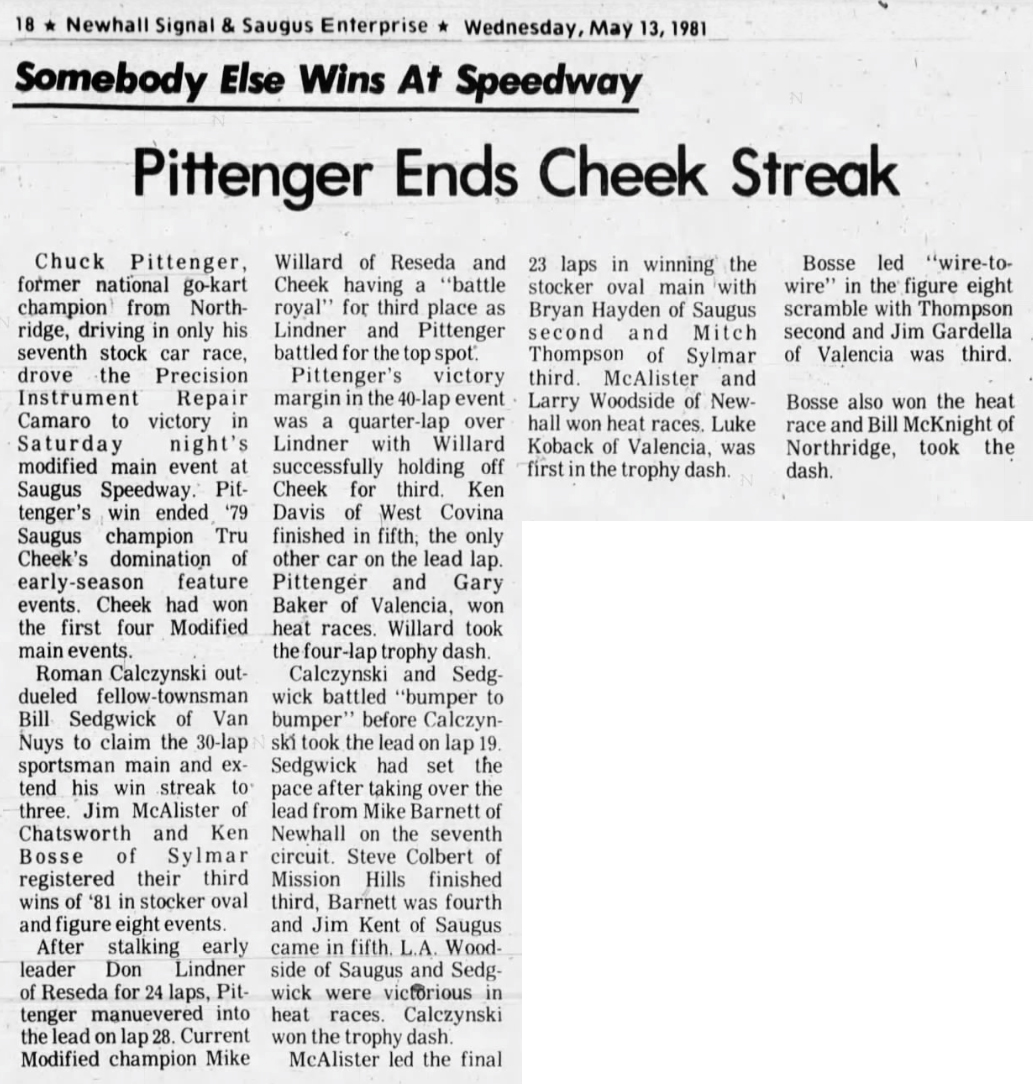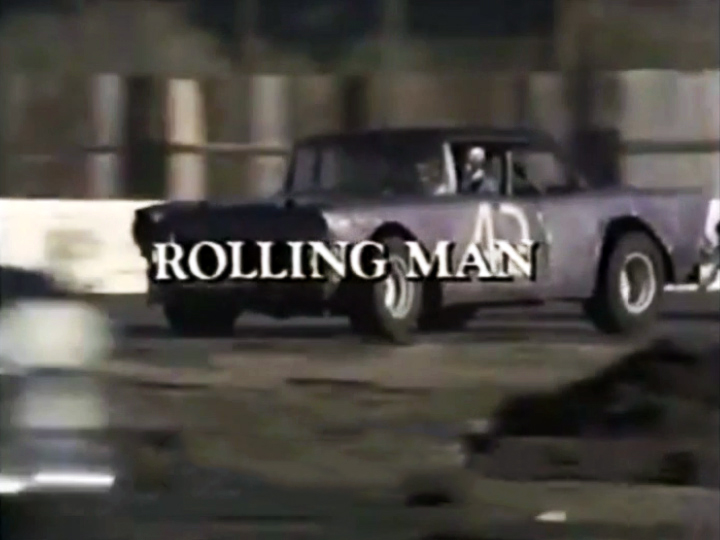|
|

Saugus Speedway Racing Program.
Saugus, California | Saturday, May 9, 1981.
|
Saugus Speedway Racing Program. Saturday, May 9, 1981. Red spot color cover, else black, 28 pages. Cover: Chuck Pittenger. Driver profile: none. Feature: Pittenger Ends Cheek's Win Streak at Saugus Speedway. Photos, in order of appearance: Pittenger, Daryl Kratz, Kenny Smith, David Shearman, Jimmy Menzi, Dennis Lape, William Converse, Kenney Christian; Bill Foster, Oren Prosser and Jon Ward (Page from the Past); Kathy Muldoon (trophy girl), Ken Richter, Scott Klassen, Jim McAlister, Mitch Thompson, Jim Kent, Bill Spears, Tru Cheek, Wrong Way Willard. Previous week's attendance: 4,785 (paid)
Pittenger Ends Cheek's Win Streak at Saugus Speedway Super Track Scene by Lyn Pherigo Chuck Pittenger, former national go-kart champion from Northridge, driving in only his seventh stock car race, drove the Precision Instrument Repair Camaro to victory in Saturday night's Modified main event at Saugus Speedway. Pittenger's win ended '79 Saugus champion Tru Cheek's domination of early-season feature events. Cheek had won the first four Modified main events. Roman Calczynski out-dueled fellow townsman Bill Sedgwick of Van Nuys to claim the 30-lap Sportsman main and extending his win streak to three. Jim McAlister, Chatsworth, and Ken Bosse, Sylmar, registered their third wins of '81 in stocker oval and figure eight events. After stalking early leader Don Lindner of Reseda for 24 laps, Pittenger maneuvered into the lead on lap 28. Current Modified champion Mike Willard, Reseda, and Cheek were having a "battle royale" for third place as Lindner and Pittenger battled for the top spot. Pittenger's victory margin in the 40-lap event was a quarter-lap over Lindner with Willard successfully holding off Cheek for third. Ken Davis, West Covina, finished in fifth, the only other car on the lead lap. Pittenger and Gary Baker, Valencia, won heat races. Willard took the 4-lap trophy dash. Calczynski and Sedgwick battled "bumper to bumper" before Calczynski took the lead on lap 19. Sedgwick had set the pace after taking over the lead from Mike Barnett, Newhall on the seventh circuit. Steve Colbert, Mission Hills, finished third, Barnett was fourth and Jim Kent, Saugus came in fifth. L.A. Woodside, Saugus, and Sedgwick were victorious in heat races. Calczynski won the trophy dash. McAlister led the final 23 laps in winning the stocker oval main with Bryan Hayden, Saugus, second and Mitch Thompson, Sylmar, was third. McAlister and Larry Woodside, Newhall, won heat races. Luke Koback, Valencia, was first in the trophy dash. Bosse led "wire-to-wire" in the figure eight scramble with Thompson second and Jim Gardella of Valencia was third. Bosse also won the heat race and Bill McKnight, Northridge, took the dash.
Results from May 9, 1981
About Saugus Speedway
About Saugus Speedway. The future Saugus Speedway was built originally as a rodeo arena in 1927 by Roy Baker, brother of shoe magnate C.H. Baker. Roy Baker purchased the 40-acre property east of Bouquet Junction in 1923 for the purpose of breeding and selling show and pleasure horses. To that end he imported saddle brood mares from Kentucky and studded them with a pedigreed, chestnut-colored saddlebred stallion named Peavine McDonald (b. 1910), which sired five pedigreed mares and four pedigreed colts between 1920 and 1936. Baker advertised that he had 2,500 acres of grazing land and also offered training and boarding services for outside horses. Probably to attract horse buyers to his ranch in faraway Saugus, Baker staged rodeos. Some references suggest he built a 12,000-seat arena in 1924, but this is dubious. (Promoter Bob Anderson organized a local rodeo in 1924, but its exact location is unclear, and it wouldn't have had grandtands.) Anderson did hold the annual rodeo on Baker's property in April 1926. That December, Baker and Anderson started construction on a new stadium, complete with partially covered grandstand seating and a quarter-mile oval track. When it opened May 1, 1927, it seated 18,000 fans, and thousands more had to be turned away for lack of room. Over the next decade, ownership of the arena would change hands three more times. As with a majority of the American populace, Baker was hit hard financially by the Great Depression of 1929 and was forced to sell the stadium to cowboy actor Hoot Gibson in 1930. Gibson continued to hold rodeos at the stadium and drew a Hollywood crowd including famous actors such as William S. Hart, Harry Carey, Tom Mix, and John Wayne. He also used the stadium as a movie set or leased it to other companies for film making. But Gibson felt the effects of the Depression, as well. In September 1933 he appeared in a Los Angeles courtroom and pleaded poverty, saying he had no assets with which to repay a $2,500 loan. He testified that he owned a one-third interest in Hoot Gibson Inc., which owned the Saugus rodeo, and that it was in arrears. In 1934, Gibson sold the stadium to Paul Hill, owner of the Western Livestock Stockyards, who continued to call it the Hoot Gibson Rodeo. As with his predecessors, however, the stadium brought Hill financial hardship when it was hit by the Great Flood of March 2, 1938. Heavy rains that year caused a river of water to flow down Soledad Canyon and filled the ranch home and arena with mud and debris. As reported in the Los Angeles Times, the "old buildings ... collapsed during the March floods" and the arena was built anew. Nonetheless, Hill lost the ranch sometime after the April 1938 rodeo. According to Reynolds, the property was repossessed by the bank. In 1939, ownership passed to William Bonelli, and it was renamed Bonelli Stadium. Bonelli, a professor of economics at Occidental College, continued the annual rodeo tradition for a number of years but introduced auto racing in 1939 on a more frequent schedule; ultimately auto racing became the primary draw and Bonelli renamed the arena Saugus Speedway. Occasional rodeos and circuses continued until at least the late 1960s, auto racing until 1995. The facility was sometimes used for concerts before the grandstands were removed in 2012 (the originals had been replaced in 1955). The venue continues to host an outdoor swap meet.
Download individual pages here.
|
SEE ALSO:
Saugus Speedway Scrapbook 1979/1995
Kurtis Midget 1950, Art 2006
~1950s
Ron Hornaday Sr.
Trophy Girl Amedee Chabot, Miss USA 1962
Aerial View 1971
Video: Rolling Man (ABC 1972)
Photo Album
1971-1975
Charlie's Angels 1976
Aerials 1979
Jason Priestly, Charlie Sheen, Charity Benefit 1991
Assessor's Map 2008
Video: Driver Reunion 8-21-2017
Legacy: Sad Sam Stanley
|
The site owner makes no assertions as to ownership of any original copyrights to digitized images. However, these images are intended for Personal or Research use only. Any other kind of use, including but not limited to commercial or scholarly publication in any medium or format, public exhibition, or use online or in a web site, may be subject to additional restrictions including but not limited to the copyrights held by parties other than the site owner. USERS ARE SOLELY RESPONSIBLE for determining the existence of such rights and for obtaining any permissions and/or paying associated fees necessary for the proposed use.














